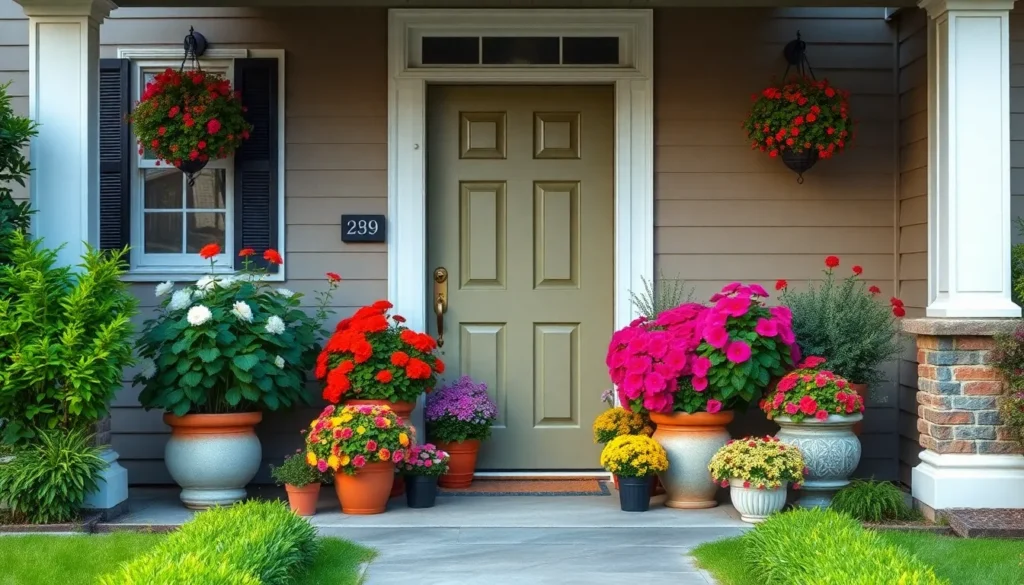Your front door creates the first impression visitors have of your home and we all know how crucial those initial moments are. The right combination of potted plants can transform an ordinary entrance into a welcoming statement that reflects your personality and style.
We’ve discovered that strategically placed front door planters don’t just boost curb appeal – they create an inviting atmosphere that makes guests feel welcome before they even ring the doorbell. From seasonal blooms that change throughout the year to evergreen arrangements that provide year-round beauty your entrance deserves plants that work as hard as you do.
The best part? You don’t need a green thumb or expensive landscaping to achieve stunning results. With the right pots plants and placement techniques we’ll show you how to create an entrance that neighbors will envy and guests will remember.
Choose the Right Size Pots for Your Front Door Entrance
Selecting appropriately sized pots transforms your entrance from ordinary to extraordinary while ensuring proper plant health and visual balance.
Consider Your Door Width and Space
Measure your door width first to determine the maximum pot size that won’t overwhelm your entrance. Standard residential doors measure 36 inches wide, which means pots should range between 12 to 18 inches in diameter for optimal proportion. Narrow doorways under 32 inches work best with smaller containers measuring 8 to 12 inches across.
Calculate your available floor space by measuring the area on both sides of your door where you plan to place containers. We recommend leaving at least 24 inches of walkway clearance for comfortable foot traffic. Doorsteps with limited space benefit from tall, narrow planters that maximize vertical growing area without blocking pathways.
Factor in architectural elements like columns, railings, or decorative trim that might restrict pot placement. These features often determine whether you need round, square, or rectangular containers to fit properly within your entrance design.
Match Pot Height to Door Scale
Position tall pots strategically to complement your door’s proportions rather than compete with them. Containers measuring 24 to 30 inches tall work perfectly with standard 80-inch residential doors, creating pleasing vertical lines without blocking door hardware or sight lines.
Choose medium height containers ranging from 16 to 20 inches for doors with transoms, sidelights, or decorative glass panels. These proportions maintain visual balance while allowing architectural details to remain the focal point of your entrance design.
Select shorter pots measuring 10 to 14 inches for compact entrances or when grouping multiple containers together. Low profile planters work exceptionally well for creating layered arrangements or filling corners where taller containers might appear top heavy.
Account for Plant Growth Over Time
Research mature plant sizes before selecting containers to avoid overcrowding as your plants develop. Small shrubs like boxwood or dwarf conifers need pots at least 18 inches wide and deep to accommodate their root systems over several growing seasons.
Plan for root expansion by choosing containers that provide 2 to 4 inches of growing room around the plant’s current root ball. This extra space prevents plants from becoming root bound and ensures healthy development throughout the growing season.
Consider seasonal plant rotations when sizing your containers for maximum flexibility. Slightly oversized pots allow you to swap seasonal annuals like pansies, petunias, or mums without purchasing new containers each time you refresh your entrance display.
Select Weather-Resistant Materials for Durability
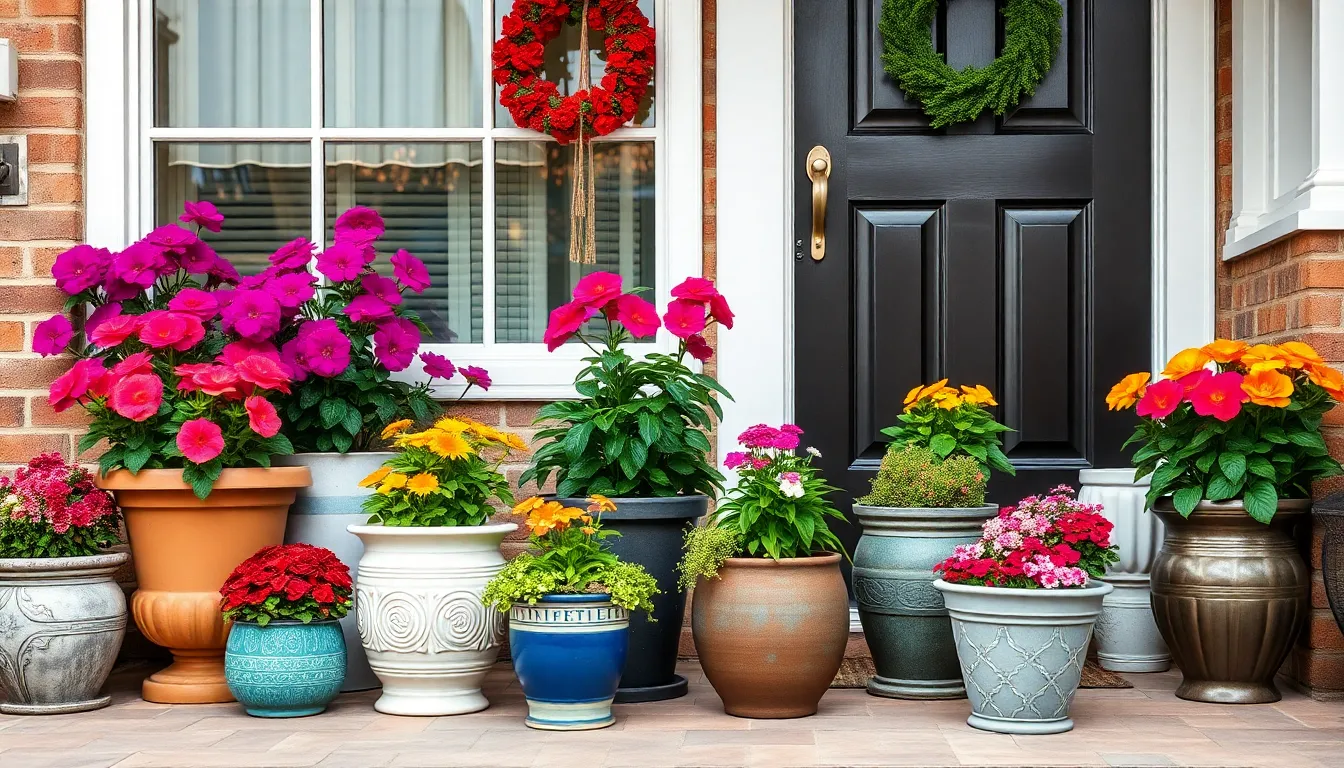
Choosing the right materials for your front door pots ensures they’ll withstand seasonal changes while maintaining their aesthetic appeal. Weather-resistant materials protect your investment and keep your entrance looking beautiful year-round.
Ceramic and Terracotta Options
Ceramic and terracotta planters bring classic charm to any entrance with their timeless appeal. Terracotta’s porous nature allows soil to breathe naturally, preventing root rot and promoting healthy plant growth. But, these materials can crack in freezing temperatures unless you select frost-resistant varieties specifically designed for outdoor use.
Glazed ceramic pots offer enhanced water resistance and come in countless styles to match your door’s aesthetic. Weight becomes a consideration with ceramic options, as they’re heavier than synthetic alternatives and more fragile in harsh weather conditions. We recommend checking product specifications for freeze-thaw ratings when selecting ceramic or terracotta pots for climates with temperature extremes.
Fiberglass and Resin Benefits
Fiberglass and resin planters deliver exceptional weather resistance while maintaining lightweight convenience. These synthetic materials resist cracking and chipping better than natural alternatives, making them ideal for entrances exposed to various weather conditions. Modern manufacturing techniques allow these materials to mimic stone or ceramic finishes at a fraction of the weight.
Low maintenance requirements make fiberglass and resin perfect for busy homeowners who want beautiful entrances without constant upkeep. UV resistance prevents fading and degradation from continuous sunlight exposure, while their non-porous surface resists moisture damage. Installation becomes easier with these lightweight options, and moving them for seasonal arrangements requires minimal effort.
Metal Planters for Modern Appeal
Metal planters create sleek, contemporary looks that complement modern architectural styles perfectly. High-grade aluminum options provide exceptional durability while remaining lightweight and rust-resistant. Powder coating on aluminum planters enhances weather resistance and ensures color retention through multiple seasons.
Corten steel planters develop natural rust-like patinas that actually protect the metal while adding rustic charm to your entrance. These weather-resistant qualities make metal planters ideal for areas with extreme temperature fluctuations or heavy precipitation. Minimal upkeep requirements mean you’ll spend more time enjoying your entrance and less time maintaining your containers.
Pick Plants That Thrive in Your Entrance Conditions

Successful front door plantings start with understanding your entrance’s unique light conditions. We recommend first assessing whether your doorway receives full sun, partial sun, or full shade throughout the day to select species that’ll flourish in those exact conditions.
Full Sun Entrance Plant Options
Entrances receiving at least 6 hours of direct sunlight daily offer excellent opportunities for vibrant, sun-loving displays. Mandevillas create stunning colorful vine arrangements that add tropical flair to any doorway. Daylilies provide resilient perennial options with bright flowers that return year after year.
Salvia delivers heat-tolerant blooms that thrive in sunny conditions and flower profusely throughout the growing season. Queen Elizabeth Roses offer disease-resistant, fragrant options suitable for USDA zones 5 to 9, with climbing varieties adding impressive vertical interest to entrance designs. Hardy Hibiscus brings bold, tropical-style blooms that require abundant sunlight to perform their best.
Additional sun-loving options include daisies, coneflowers, and black-eyed susans for cheerful displays. Lantanas, verbenas, and geraniums provide continuous color with minimal maintenance. Pentas, spider flowers, and cosmos round out the selection with varied textures and heights that create ever-changing arrangements.
Shade-Tolerant Varieties for Covered Entries
Shaded or covered entrances benefit from plants that flourish without direct sunlight exposure. Begonias, particularly Dragon Wings varieties, produce vivid blooms throughout the season and perform exceptionally well in shady container environments. These plants act as perennials in warmer zones, providing long-term value for entrance plantings.
Ferns offer excellent green foliage options that create lush, welcoming displays in low-light conditions. Hostas complement ferns beautifully and provide varied leaf shapes and sizes for textural interest. Both options maintain their appeal throughout the growing season without requiring direct sun exposure.
Certain impatiens varieties excel in shaded entrance conditions, delivering continuous blooms in containers. Coleus provides striking foliage colors that brighten dim entrance areas with its vibrant leaf patterns and textures.
All-Season Plants for Year-Round Appeal
Container gardening allows flexible seasonal rotations that maintain visual interest throughout the year. We suggest using perennials and hardy shrubs that can overwinter in pots or transition to garden beds afterward, such as roses or cold-hardy begonia varieties.
Evergreen plants and small shrubs provide essential structure during winter months when flowering plants go dormant. These foundation plants anchor your entrance design and ensure year-round appeal even when seasonal blooms fade.
Strategic container mixing using the “spiller, thriller, filler” design principle creates professional-looking arrangements. Choose one trailing plant to spill over container edges, select one eye-catching “thriller” plant as the focal point, and add filler plants to complete the composition. This approach ensures balanced, visually appealing displays that work across all seasons.
Create Visual Balance with Symmetrical Arrangements
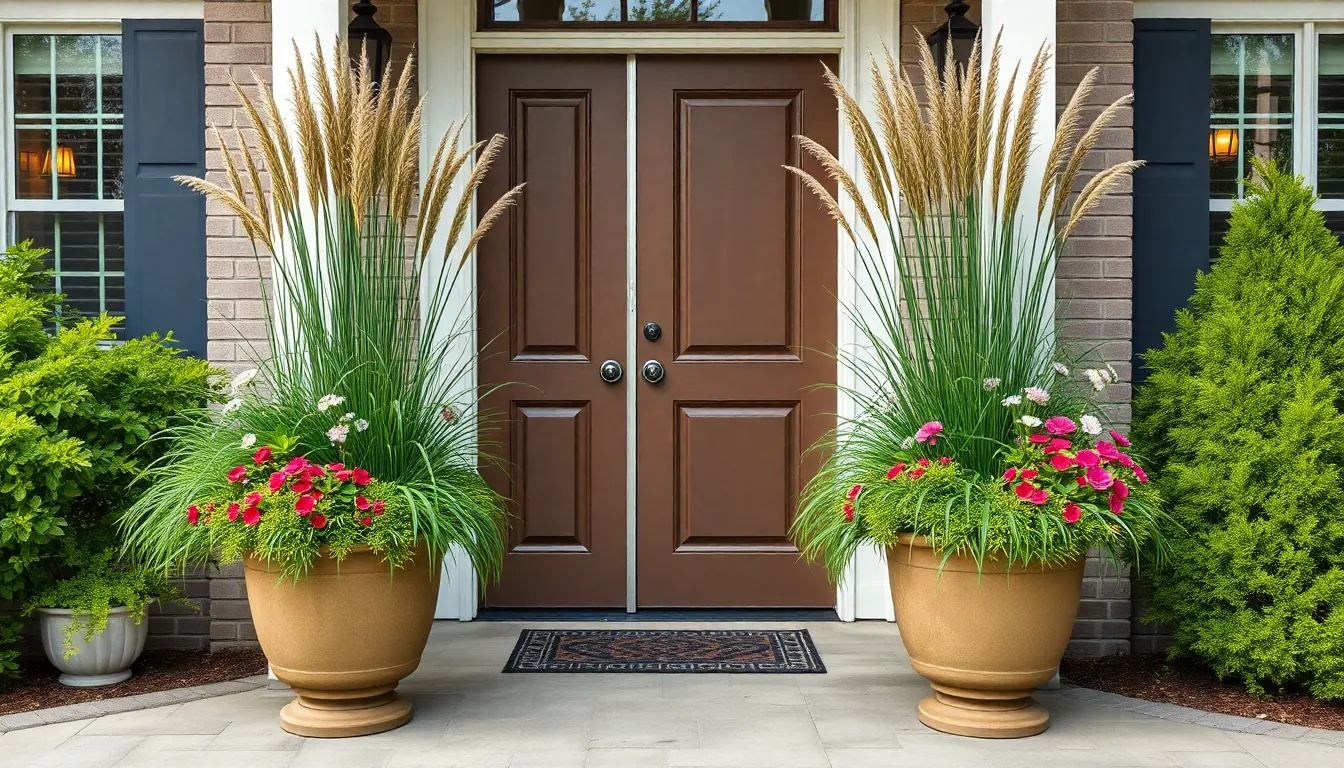
Strategic placement of your front door pots creates an inviting entrance that draws visitors in. Visual balance transforms an ordinary doorway into a stunning focal point that enhances your home’s curb appeal.
Mirror Matching Pots on Both Sides
Identical planters positioned on each side of your entrance door establish instant symmetry that’s both elegant and welcoming. This mirror matching approach creates formality while framing your doorway with sophisticated appeal. Large planters filled with topiaries or elephant ear plants dramatically enhance the entrance with impressive height and rich texture.
Matching containers work exceptionally well for formal home styles like Colonial, Georgian, or Mediterranean architecture. We recommend choosing substantial pots that complement your door’s proportions without overwhelming the space. Consider using identical plants in each pot to maintain the symmetrical effect, or select complementary varieties that share similar growth habits and care requirements.
Use Odd Numbers for Single-Side Displays
Grouping three or five containers on one side of your entrance creates natural, ever-changing balance without rigid formality. Odd numbered arrangements engage the eye more effectively than even groupings while maintaining visual harmony. This approach works particularly well for asymmetrical home designs or when space limitations prevent bilateral placement.
Position your odd numbered pots at varying distances from the door to create depth and interest. The largest container should anchor the arrangement closest to the entrance, with smaller pots stepping away in descending size order. This graduated approach guides visitors’ eyes naturally toward your front door while creating an organic, welcoming display.
Vary Heights for Ever-changing Interest
Combining planters of different heights adds essential depth and layering to your front door arrangement. The “Thriller, Filler, Spiller” design method creates stunning displays through strategic plant placement at varying elevations.
Thrillers serve as your arrangement’s focal points with tall, structural elements like cannas or ornamental grasses that draw attention upward. These dramatic plants establish your display’s vertical presence and create impressive visual impact.
Fillers provide essential volume and color through medium height plants that flesh out the middle section of your containers. These plants bridge the gap between your tallest specimens and trailing varieties while contributing seasonal interest.
Spillers soften container edges with cascading plants that flow gracefully over pot rims. Trailing calibrachoas or creeping jenny create lush, complex displays when paired with taller hydrangeas or structural plants.
This layered approach ensures your entrance maintains visual interest from multiple viewing angles while creating the depth that makes professional looking arrangements truly captivating.
Incorporate Seasonal Color Changes
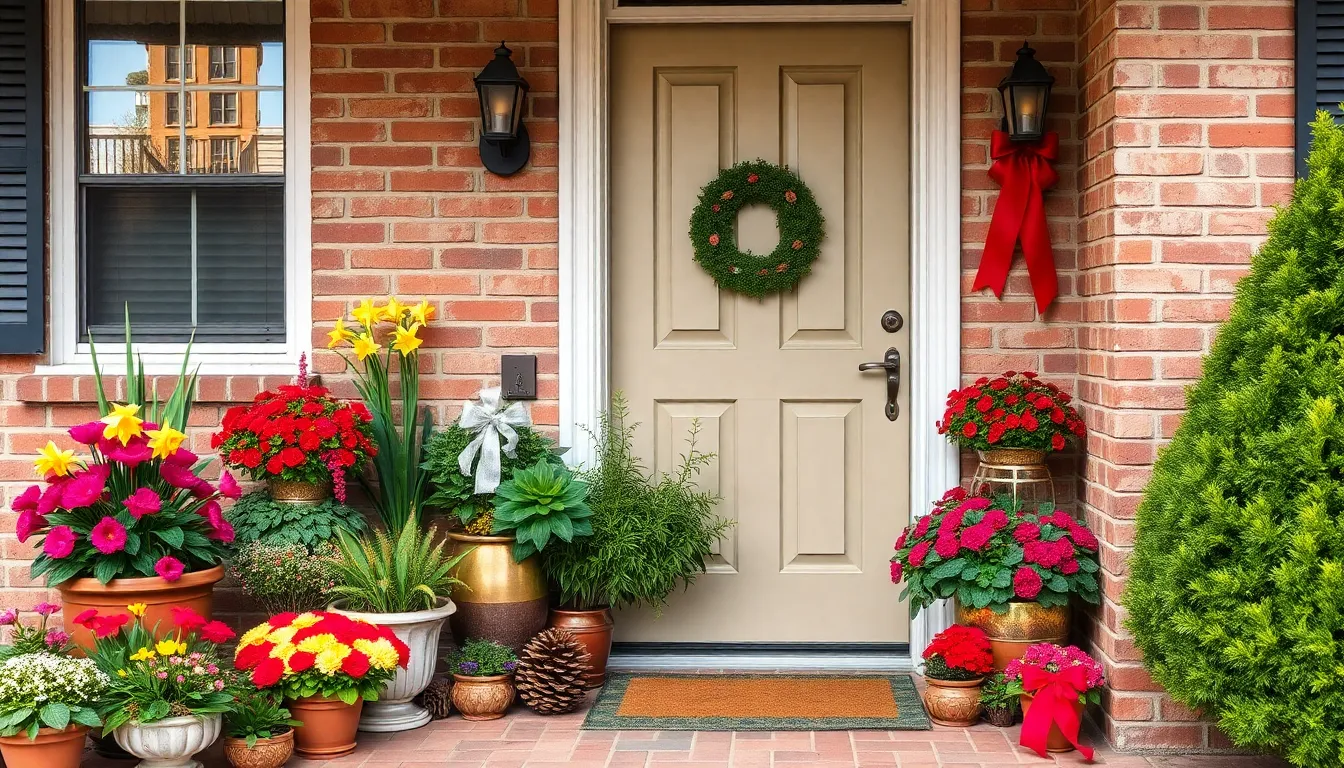
Seasonal color changes keep your front door entrance vibrant and fresh throughout the year. We’ll show you how to transition your potted plants with each season to maintain maximum curb appeal.
Spring Bulbs and Fresh Greens
Spring awakens your entrance with vibrant bulbs that herald the season’s arrival. Tulips and daffodils provide brilliant pops of color while English ivy cascades elegantly from containers. Thyme topiaries offer both visual appeal and delightful fragrance that welcomes guests with natural aromatherapy.
Hydrangeas create stunning focal points with their abundant blooms and full foliage. Climbing star jasmine adds romantic appeal with its sweet scent and delicate white flowers. These combinations create that fresh, clean aesthetic that perfectly captures spring’s renewal energy.
Summer Blooms and Vibrant Foliage
Summer transforms your entrance into a bold, lush paradise that commands attention. Elephant’s ear plants provide dramatic leaves that create instant tropical elegance. Petunias deliver continuous blooms in vibrant colors while million bells cascade beautifully from containers.
Salvia adds vertical interest with its spiky flowers and attracts beneficial pollinators to your entrance. Rosemary contributes texture and aromatic appeal while serving dual purposes as decoration and herb. Foxtail ferns thrive on covered porches with their unique needle-like fronds that add sophisticated texture to your summer displays.
Fall Textures and Warm Tones
Fall welcomes guests with rich textures and warm color palettes that reflect autumn’s beauty. Ornamental cabbage provides stunning foliage in purples and greens that intensify as temperatures cool. Waxleaf privet topiaries maintain structure while adding elegant sophistication to your arrangements.
Creeping jenny creates beautiful contrast with its trailing golden foliage that brightens shadowy areas. Purple coneflowers offer unexpected pops of color that complement fall’s warm palette while providing seeds for visiting birds. These combinations create depth and visual interest that celebrates harvest season.
Winter Evergreens and Holiday Accents
Winter maintains your entrance’s appeal with evergreen plants that provide year-round structure and color. Boxwoods offer classic elegance with minimal maintenance requirements throughout cold months. Gardenias contribute glossy green leaves and occasional winter blooms that surprise and delight.
Holiday accents transform your winter display into festive celebration focal points. Pine cones add natural texture while ribbons introduce seasonal colors that complement your home’s exterior. String lights create magical ambiance during shorter winter days and extend your entrance’s welcoming appeal into evening hours.
Ensure Proper Drainage and Plant Health
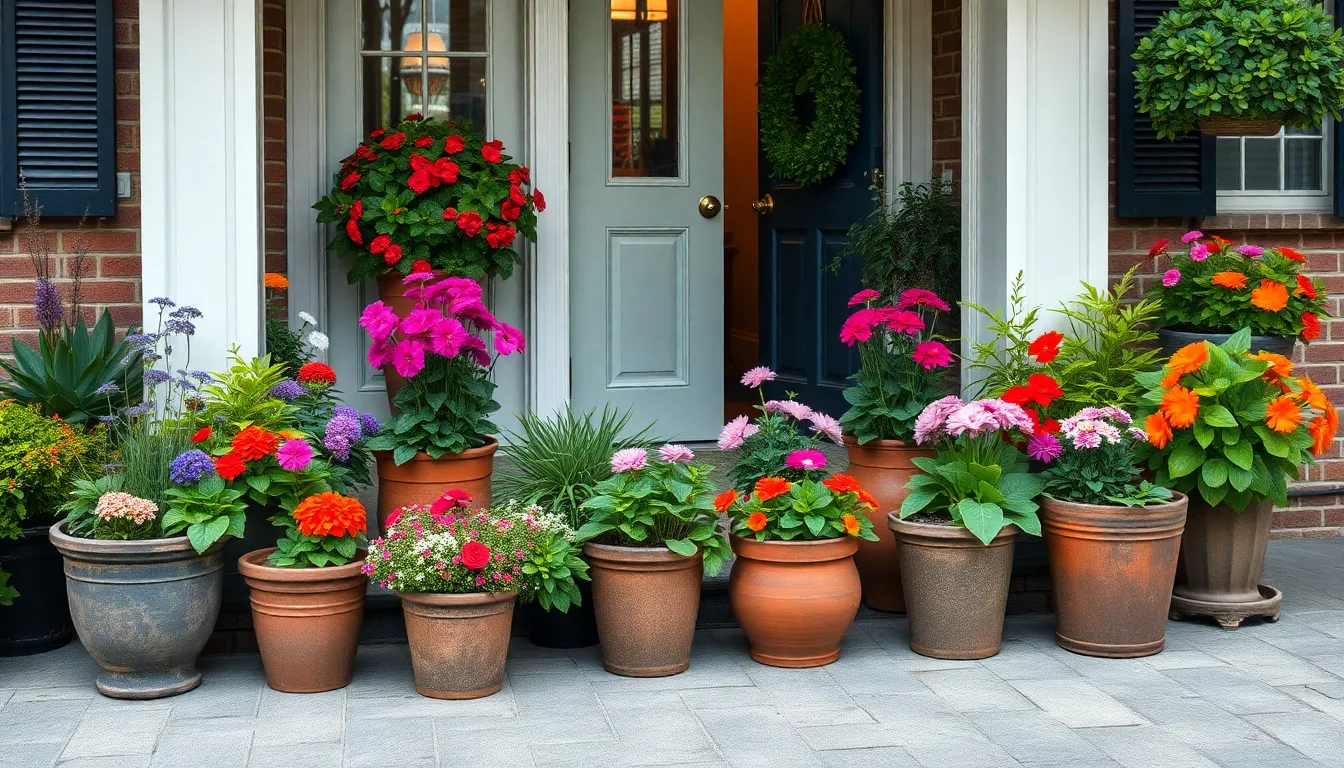
Creating thriving front door displays requires proper drainage and plant care practices that keep your entrance containers healthy and vibrant throughout the seasons.
Add Drainage Holes to Prevent Root Rot
Drainage holes are essential for preventing water accumulation that causes root rot in container plants. We recommend choosing pots with pre-existing drainage holes or adding them yourself if they’re missing. Before planting, verify that water can freely escape from the bottom of each container.
Water should drain from the bottom holes after thorough watering, indicating that moisture has penetrated deeply into the soil. This drainage process prevents waterlogged conditions that suffocate plant roots and lead to decay. Container plants depend on this oxygen flow to maintain healthy root systems and proper metabolic activity.
Use Quality Potting Mix for Container Plants
High-quality potting mix designed specifically for containers provides the foundation for healthy front door plants. We avoid using heavy garden soil in pots since it impedes root oxygen and metabolic activity crucial for container plant success. Garden soil compacts in containers and prevents proper drainage, unlike specialized potting mixes that remain light and well-draining.
Container potting mixes are nutrient-rich and formulated to provide optimal growing conditions in confined spaces. These specialized soils maintain proper structure even after repeated watering cycles, ensuring your front door plants receive adequate nutrition and root support.
Establish Regular Watering Schedules
Regular watering schedules keep front door container plants properly hydrated without overwatering risks. We water when the soil surface feels dry, which often means daily watering during hot weather to ensure thorough moisture penetration to the roots. Consistent watering practices prevent stress and maintain plant health throughout seasonal changes.
Timing matters significantly for plant health and disease prevention. We avoid watering late in the day to prevent prolonged leaf wetness that encourages foliar diseases. Morning watering allows plants to absorb moisture before heat stress and gives foliage time to dry before evening.
Container soils lack natural nutrients, so we supplement with time-released granular fertilizers at planting time. Every 2-3 weeks, we apply diluted liquid fertilizer to provide continuous feeding that supports vigorous growth and abundant blooms in our front door displays.
Style Your Entrance with Complementary Accessories
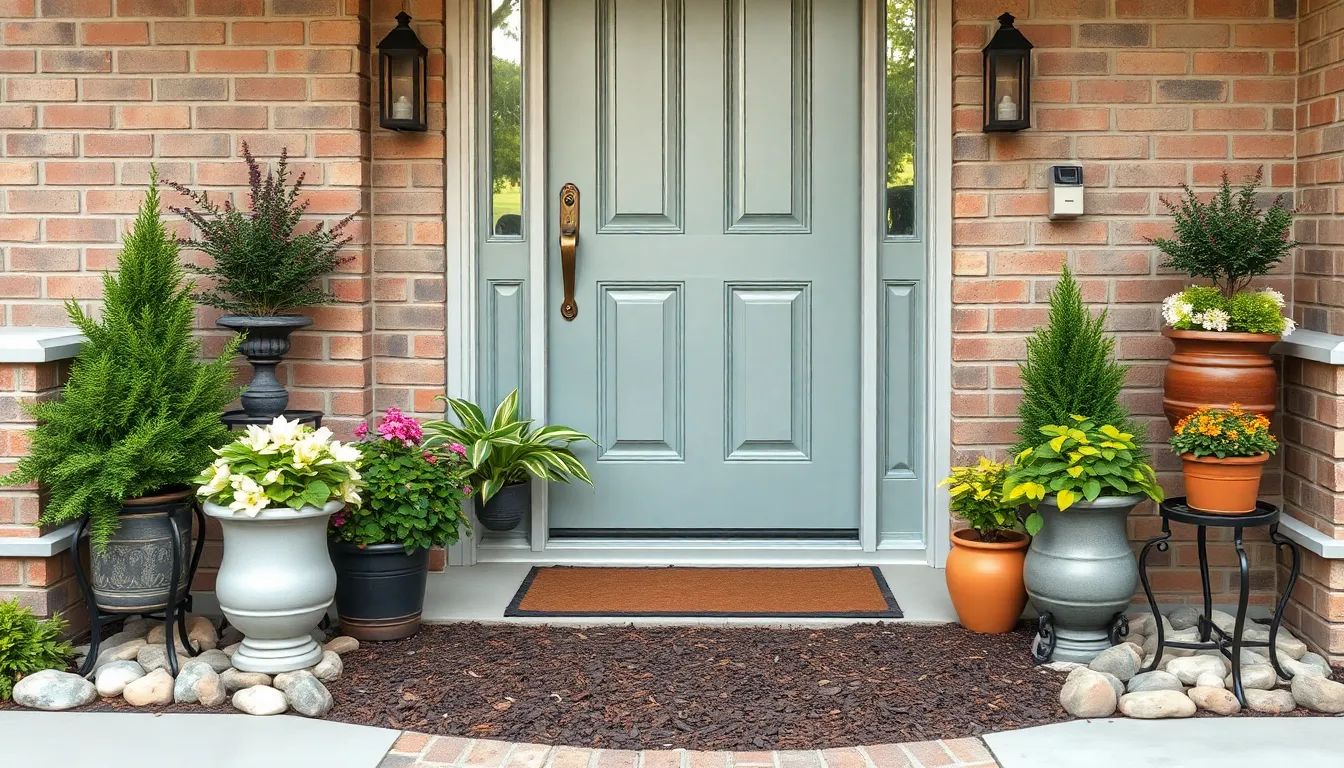
Transform your front door entrance into a cohesive design masterpiece by incorporating thoughtful accessories that enhance your potted plant displays. We’ll explore how strategic additions can elevate your entrance from simple to stunning.
Add Decorative Mulch or Stones
Decorative mulch creates natural texture contrasts that soften the transition between your hardscape elements and greenery. We recommend using locally sourced materials to strengthen the connection between your entrance design and the surrounding environment. Alternating rocks and mulch adds visual appeal while defining distinct planting areas around your pots.
Stones provide structural dimension that complements the organic shapes of your plants and containers. Natural stone varieties help your entrance blend seamlessly with existing industry features while adding authentic character. Mulch softens harsh stone pathways and creates gentle visual flow between different entrance elements.
Strategic placement of these materials around your pots reinforces the natural aesthetic you’ve established with your plant selections. Both options offer practical benefits by helping retain soil moisture and reducing maintenance requirements for your entrance displays.
Include Plant Stands or Pedestals
Plant stands elevate your containers to create ever-changing height variations that add visual interest and grandeur to your entrance. We position pedestals strategically to frame the front door while establishing symmetrical balance in your overall design. Elevated displays draw the eye upward and create layers that make your entrance feel more dimensional.
Organizing pots at different heights helps establish hierarchy in your plant arrangements while ensuring each element receives proper attention. Metal plant stands can echo the tones found in your door hardware for enhanced coordination. Pedestals also provide practical benefits by improving drainage and air circulation around your containers.
Strategic elevation creates better visibility for your carefully selected plants while adding architectural structure to your entrance composition. This approach helps your entrance feel more intentional and professionally designed.
Coordinate with Door Hardware and Lighting
Door hardware tones should complement the materials and colors you’ve chosen for your plant containers and stands. We match metal finishes between planters and door handles to create unified visual flow throughout the entrance design. Bronze, black, or brushed nickel elements can tie together various components of your display.
Outdoor lighting serves dual purposes by highlighting your plant arrangements while providing essential safety illumination for evening hours. Strategic placement of fixtures can showcase your potted displays after dark and extend the visual impact of your entrance design. Coordinated lighting fixtures that match your hardware finishes create seamless integration.
Proper lighting adds curb appeal by ensuring your carefully crafted entrance remains attractive and welcoming throughout all hours. This coordination between functional elements and decorative choices demonstrates attention to detail that elevates the entire entrance aesthetic.
Maintain Your Front Door Container Garden
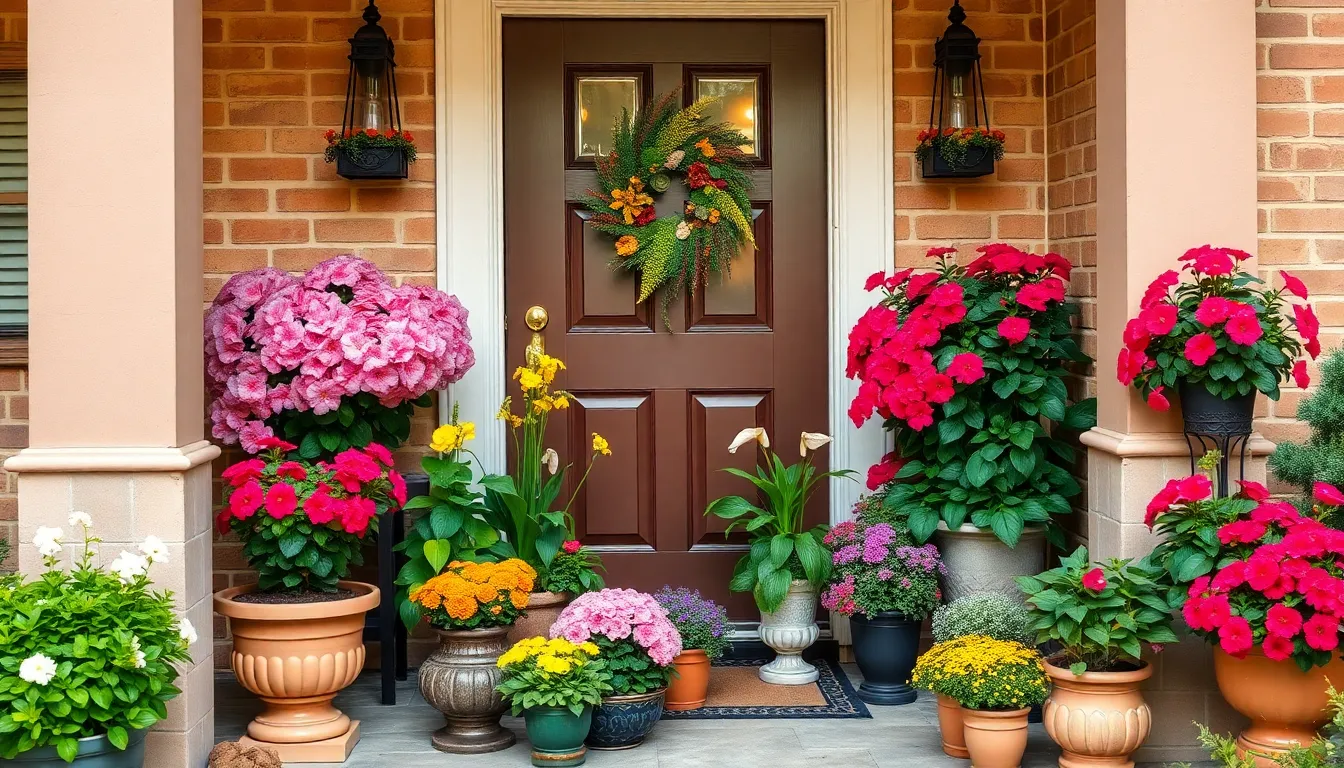
Maintaining our front door container garden requires consistent attention to keep plants thriving and our entrance looking spectacular. Regular maintenance practices ensure our seasonal displays remain vibrant and healthy throughout the year.
Pruning and Deadheading Techniques
Deadheading spent blooms redirects plant energy toward new flower production, improving flowering throughout the season. We should remove dead flowers regularly to keep our container displays looking fresh and encourage continuous blooming. Trimming back overgrown plants sustains the overall aesthetic and prevents some species from dominating others in mixed arrangements.
Occasional pruning maintains balanced proportions in our planters by preventing certain plants from outgrowing their companions. We need to assess each container weekly during growing season to identify plants that need trimming. Cutting techniques vary by plant type – pinch soft stems with fingers for delicate flowers like petunias, while woody stems require clean pruning shears.
Fertilizing Schedule for Potted Plants
Weekly liquid fertilizer applications during growing season maintain strong blooms and healthy foliage in container plants. Container soil depletes nutrients faster than in-ground gardens, making scheduled fertilizing essential for sustained plant vitality. We should apply fertilizer approximately once per week from spring through early fall when plants are actively growing.
Water-soluble fertilizers work best for container applications because they distribute nutrients evenly throughout the soil. We can alternate between balanced fertilizers and bloom boosters to support both foliage growth and flower production. Reduce fertilizing frequency in late fall as plants prepare for dormancy and growth naturally slows.
Pest and Disease Prevention Tips
Cleaning up plant debris and dead material reduces breeding grounds for insects and pathogens that can quickly spread in container environments. We should remove fallen leaves, spent blooms, and any diseased plant parts immediately to prevent pest infestations. Good airflow around containers reduces fungal problems that thrive in humid, stagnant conditions.
Regular monitoring helps us catch pest issues early before they become serious problems requiring intensive treatment. We need to inspect plants during weekly maintenance for signs of aphids, spider mites, or disease symptoms. Well-draining soil prevents root diseases caused by excess moisture, which is why proper drainage holes and quality potting mix are crucial for plant health.
Conclusion
Creating an inviting entrance with thoughtfully chosen potted plants transforms your home’s first impression while boosting curb appeal. We’ve covered everything from selecting the perfect container sizes to implementing proper care routines that keep your displays thriving year-round.
Remember that success lies in understanding your space’s unique conditions and choosing plants that’ll flourish in those exact environments. Whether you’re working with full sun or shaded entries the key is matching your selections to what works best for your doorway.
With these strategies in place you’re well-equipped to design and maintain stunning front door displays that welcome guests beautifully while reflecting your personal style. Your entrance will become a source of pride that enhances your home’s value and charm for years to come.
Frequently Asked Questions
What size pots should I use for my front door entrance?
For standard doors, choose pots between 12 to 18 inches in diameter. Smaller containers work better for narrow doorways. Always measure your door width first and ensure adequate walkway clearance. Consider your door’s architectural features and select pot heights that complement the scale – tall pots for standard doors, medium or shorter containers for specific architectural elements.
Which materials are best for front door planters?
Weather-resistant materials are essential for durability. Ceramic and terracotta offer classic charm but need frost-resistant options in cold climates. Fiberglass and resin planters are lightweight and exceptionally weather-resistant, perfect for busy homeowners. Metal planters like high-grade aluminum and Corten steel provide modern appeal with excellent durability against harsh weather conditions.
How do I choose plants for different light conditions at my entrance?
Assess your doorway’s light exposure first. For full sun entrances, choose vibrant options like Mandevillas, Daylilies, and Queen Elizabeth Roses. For shaded or covered entries, select shade-tolerant varieties such as Begonias, ferns, and Hostas. Consider your specific microclimate and seasonal light changes when making selections.
What is the “thriller, filler, spiller” design principle?
This principle creates visually appealing container arrangements using three plant types: “thriller” (tall, eye-catching centerpiece), “filler” (medium plants that fill space), and “spiller” (trailing plants that cascade over edges). This method ensures balanced displays with varied heights and textures that maintain interest from multiple viewing angles throughout the seasons.
How should I arrange multiple pots at my entrance?
For formal looks, use matching pots on both sides of your entrance. For single-side displays, arrange pots in odd-numbered groupings for natural balance. Vary heights to add depth and visual interest. Consider your walkway width and architectural elements when positioning containers to ensure both aesthetic appeal and practical functionality.
What plants work best for year-round displays?
Choose all-season plants like perennials and hardy shrubs that can transition from containers to garden beds. Evergreens such as boxwoods and gardenias provide consistent structure. Combine these with seasonal rotations: spring bulbs, summer blooms like petunias, fall textures with ornamental cabbage, and winter holiday accents for continuous appeal.
How often should I water my front door container plants?
Establish regular watering schedules based on plant needs, season, and weather conditions. Container plants typically need more frequent watering than ground plants. Check soil moisture regularly and water when the top inch feels dry. Adjust frequency for seasonal changes and ensure proper drainage to prevent root rot.
What maintenance do front door planters require?
Regular pruning and deadheading encourage continuous blooming and maintain plant proportions. Apply liquid fertilizer weekly during growing season for optimal plant vitality. Monitor for pests and diseases, clean up plant debris promptly, and ensure proper drainage. Seasonal plant rotations keep displays fresh and vibrant year-round.

